



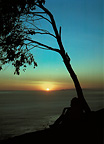
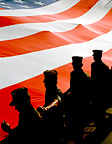






The Friedman Archives Newsletter September 2008
In this issue:
Grandchild arrives - how these portraits were made
Please welcome our first grandchild, Mikah James Clark to the world. And rather than acting like a doting grandfather, telling you how wonderful and angelic he is, I'll just share with you some pictures, taken when he was 1 week old:





How were these shots taken? Did it require an expensive studio with thousands of dollars worth of lights? NO!!! Anyone who knows me knows that I like to get by with as little equipment as possible. (I refuse, for example, to invest in "professional" studio lights - they are big, expensive, are a pain to set up and take down, and don't offer TTL flash exposure metering for those times I'm shooting on location under a time crunch.) The images above (and the maternity shots at the end of last month's newsletter) were taken with only ONE flash (the Minolta 5600HS) and one softbox (which was designed to work specifically with wireless flashes, the Lastolite EZYBOX softbox). A large black bedsheet was hung on the wall behind them with duct tape. The softbox was set up to the left, and my wife held up a giant white sheet to the right (to act as a reflector to lighten the shadows). To see the benefit of the fill sheet on the right, have a look at these test shots, taken with a different dad and a different baby:
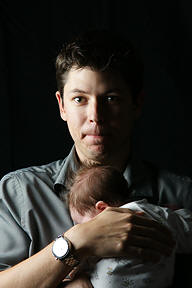
Without white reflector |
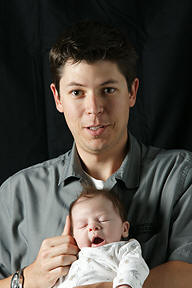
With white reflector |
That's it! Cheap but great lighting. (The lighting is so good, in fact, that nobody will ever look at these shots and say, "Gee, those are great pictures... what kind of camera do you have?" :-) ) If you can't afford a softbox, I've found that bouncing the flash into a giant sheet also works well (as long as the sheet is close to your subject). The only requirement is that the light be soft, and there are many ways to achieve that effect.
Because the dark background would likely have thrown off the automatic exposure, I set the 5600 flash to "Manual Output" (1/2 power, I believe) and that was that. Also, because the softbox can easily obscure the control signals from my camera's pop-up flash to the softbox flash, I mounted the flash onto the bracket (with the aid of the Sony / Minolta OS-1100 off-camera shoe adapter) sideways like in the photo below, so that the flash's light receiver was pointing toward the camera, while the flash head itself was directing its light into the rear of the softbox.

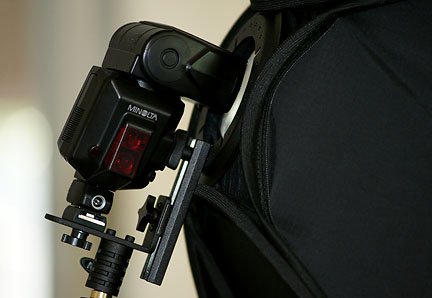
When I'm in the studio, one of the biggest problems I have is "Okay, what shall we shoot next?" Coming up with novel compositions on the spot with time pressure can be a source of stress. The solution? Spend some time in pre-production sketching out some of the ideas you have for shots. (In other words, pre-visualize the image.) To aid the process, the baby's mother scoured the web and sent me some samples of other photographers' works and said "Here, can you take a picture like this?" Is this plagiarism? Maybe, but in the world of portraits it happens all the time, and you can use this technique as a jumping-off point and then create your own original shots afterwards. (You can't copyright a pose! :-) )
A900 ebook - What should be included?
I'm sure many of you are already aware that Sony has officially introduced their A900 camera, a full-frame DSLR with the most megapixels than any other 35-mm-based DSLR on the planet (that includes the Canon 1DS Mk III, although who knows what the 5D-II might bring)) and for a price of about USD $5,000 LESS than the Canon. Wow. In my life, even in the days when I shot film, I never had access to ANYTHING that produced images this detailed. In my day, when you wanted what the A900 offers, you had to go to medium format. This price point is a miracle of capitalism. I can't wait to get my hands on one.
Sony seems to have done everything right about this camera: Biggest and brightest viewfinder (exceeding even that of the much-heralded Dynax / Maxxum 9, Minolta's last Professional-caliber camera), image stabilization using a much larger and heavier sensor, and a control layout similar to the A700. In my mind, they did everything right except one thing: There is no convenient way to trigger wireless flashes! (And I shoot with wireless flash, like, a lot!) According to Sony, the ONLY way to trigger off-camera flash via their wireless system is to mount a very heavy (but very capable) $500 HVL-58AM flash on top of the camera. This is a step backwards. What was Sony thinking?
Okay, that was a rhetorical question. I think I know what they were thinking. They were paying attention to market research, which reflected the "simple common knowledge" that professional-caliber cameras don't have pop-up flashes. And they were probably paying attention to history, too. I distinctly remember when Minolta introduced its professional-level Maxxum 9 (which I still own and love), and it was widely criticized by the photo media as being "non-pro" because it had a pop-up flash. (I wonder what that says about the Hasselblad H1?) What these media idiots didn't realize was that the pop-up flash was there to trigger wireless flashes cheaply and easily (a foreign concept for all other brands at the time).
And while Sony has no official plans to come up with a small, infrared wireless controller similar to the Canon ST-E2 (or even the Minolta Infrared Wireless Flash Controller but one that will work with digital bodies), they DID produce something that would appeal to *real* professional photographers: the FA-HS1AM, which converts the proprietary Sony hot shoe into a "standard" (ha!) hot shoe, allowing you to attach a Pocket Wizard or any other standard 3rd party flash accessory on the camera. This might appear to be identical in function to the older Minolta FS-1100 hot shoe adapter, however FS-1100 won't work at all on any Minolta or Sony camera made since the Maxxum 9. (I explain all this in my Advanced Topics 1 guide, available here. :-) )
Regardless, I have an A900 on order, and of course I will be enthusiastically writing a book about it. But, there's a conundrum: Most of my books are targeted at beginners, which is why I carefully explained f/stops, shutter speeds, rules of composition, and the mysteries of .jpg, RAW, and histograms. I can't fathom that anyone who would spring $3,000 for the A900 wouldn't already know most of this stuff. What should a book on the A900 include? Perhaps more importantly, what should it leave out? Shall I ditch all of Chapter 3? Please let me know you thoughts at Gary@FriedmanArchives.com.
Two of the differentiating features between the A900 and the A700 is 1) the ability to turn Noise Reduction OFF (a valuable feature because the camera's native noise reduction interferes with the effectiveness of commercial, post-processing noise-reduction software) and the ability to do wide bracketing (3 pictures, each 2-stops apart) for doing High Dynamic Range photography (which I'll explain in detail in the upcoming Advanced Topics 2 e-booklet).
You can download and install the free firmware upgrade here. Unzip it, copy the .app file to a compact flash memory card, put it into your A700, and turn the camera ON while holding down the menu button. Say "Yes" when prompted to upgrade, and wait about a minute. Voila!
The Kindest of Pickpockets
So here we were in Paris, where I was shooting the new, blue-lit Eiffel Tower (France is marking the start of its six-month presidency of the European Union by lighting up the Eiffel Tower in blue with yellow stars, recalling the EU flag.) The trip was over, and my wife and I, being non-snooty travelers, decided to take public transportation to the airport rather than hiring a cab. We must have been easy-looking targets, carting our luggage around and trying (and failing) to get past the subway turnstyles. Another subway rider who appeared to be in a hurry was behind me, and reached over me to try to help get the turnstyle unstuck. Half a minute later, success. Me and my luggage were through the turnstyle, and the stranger, interestingly, did not follow me in.


(More pictures of France can be seen at http://friedmanarchives.com/France .)
15 seconds went by when I suddenly asked myself, "Where's my wallet?" Another 15 seconds elapsed when I finally came to the inevitable conclusion: "I had been pickpocketed!!!"
Of course now all those warnings I've been reading about, to watch out for pickpocketers, just now registered. We couldn't really report the incident; that would have made us late for the plane. I looked around in desperation, thinking maybe it just fell out of my pocket or something. And there, still on the other side of the high-walled turnstyle (and untouchable) was the guy who took my wallet. And he made eye contact with me, as if he was trying to tell me something. He pointed to the ground. (Was it the ground?) He stayed and continued to point until I figured out the meaning of his ambiguous gesture: he was pointing to my wallet that was on top of the turnstyle. (Or, more correctly, he placed it there.) I grabbed my wallet and headed toward the trains. He exited the subway, no doubt to pursue another victim.
I quickly rummaged through my wallet. All the credit cards were there, as was the driver's license and other important paperwork. The cash? Gone. About $180 dollars worth.
Once we got settled on the train, I reflected on how much worse it could have been. How many pickpockets do you know would only take the cash and go out of their way to give you back the rest of the wallet? Countless hours and hassles reporting and then replacing stolen credit cards had been avoided. The incident turned what could have been a major disaster into a minor footnote for the trip. Fagin trained him well. And I'm an idiot for forgetting my money belt on this trip.
Here's another tip for you North Americans who think that your Visa and MasterCard credit cards are accepted worldwide: They are, but there's a really good chance that the card you're carrying won't be. Have a look at the two pictures below:
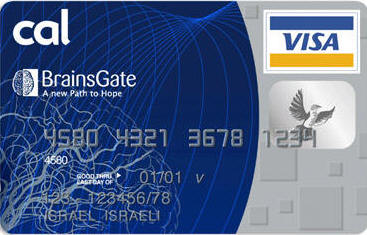
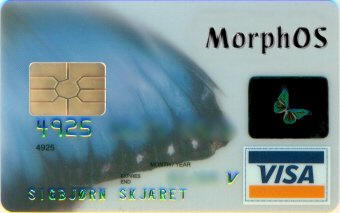
The left image is a standard credit card, with an embedded hologram put there to try to reduce counterfeiting. The right image is a newer credit card; in addition to having the magnetic stripe on the back (containing the card number and user name), there is also a metallic array of contacts on the left to support a tiny memory chip (sometimes called a "smart chip") embedded within the card itself. Many, many cashiers in Europe cannot tell these two apart; they think that anything shiny on the front of the card makes it authentic. (So they would run the card several times in a new reader, and wonder why it won't work.)
Worse, some automated payment machines (parking meters, highway toll booths, subway ticket dispensing machines) will ONLY work with the smart chip. Conventional credit cards with the mag stripe (even legitimate ones!) are paymenta non grata. Visa may be "everywhere you want to be", but just try to buy a subway ticket at 1:30 in the morning in an automated terminal with no employees (and no cash on hand) and just see how far you get.
So if you find yourself planning a trip to Europe, make absolutely sure you either get yourself one of these newer cards (hard to do in North America) or utilize the tried-and-true technique of obtaining lots of cash in the local currency.
Seminar and Expedition Update
The next Friedman Archives High-Impact Photography Seminars are scheduled for the following dates:
| Boston (Somerville) | October 18-19, 2008 | Click Here to Register |
| Southern California | February 21-22, 2009 | Click Here to Register |
| Northern California | February 28-Mar 1, 2009 | Click Here to Register |
For those of you new to the newsletter, the Friedman Archives Seminars are designed to do three things extraordinarily well: 1) Ease the learning curve for digital photography, for both beginners and advanced shooters, and 2) do it in such a way that the concepts are retained in long-term memory, and 3) do it in a way that is fun, entertaining, approachable, and completely non-intimidating. Sign up now, or register your interest in having it come to your home town at www.FriedmanArchives.com/seminars .
We still intend to schedule Copenhagen and Amsterdam for 2009 but have just not had any time to arrange it. Stay tuned for more news!
China Expedition
The Photo Expedition to vanishing rural China is open to all photographers of all religions (ahem - I mean "camera brands") and will be transpiring on March 16-25, 2009. We planned it for 2009 specifically to escape the Olympics frenzy, and we will be visiting tribes and villages that are off the beaten path and very much cut off from the urban bustle of Beijing or Shanghai. A once-in-a-lifetime opportunity!
For logistics purposes, everyone who would like to join us MUST sign up by December 31st, 2008. You can learn more about this amazing trip -- custom-designed for the unique needs of photographers -- at www.FriedmanArchives.com/expeditions/china . But you mustn't tarry -- there are only 14 slots available!
Until next time...
Yours Truly,
Gary Friedman
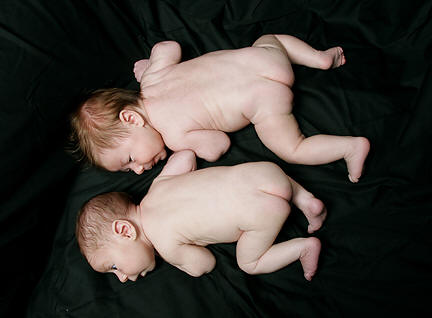
Previous Newsletter - August 2008 Next Newsletter - November 2008 Newsletters Main Page
Back to the Friedman Archives Home page